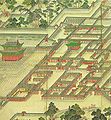- Donggwoldo
-
Donggwoldo
동궐도
Artist Presumably royal painters Year Around 1830 Type Ink on paper and silk Dimensions 274 cm × 583 cm (108 in × 230 in) Location Korea University Museum
Dong-A University MuseumDonggwoldo Hangul 동궐도 Hanja 東闕圖 Revised Romanization Donggwoldo McCune–Reischauer Tongkwǒldo Donggwoldo (literally "Painting of the Eastern Palace")[1] is a representative Korean painting of the early 19th century, depicting the two royal palaces, Changdeokgung and Changgyeonggung during the Joseon Dynasty. Donggwol is an alternative name of Changdeokgung, located to the East of the main royal palace of the dynasty, Gyeongbokgung. However, the picture also includes Changgyeonggung, an adjacent palace to the former.[2][3]
Contents
Features
The picture from a bird's-eye view perspective[4] captures the whole scape of the palaces surrounded by mountains and hills from a right top angle. Two versions of the same picture have survived to the present; one with a width of 583 cm and a height of 274 cm is stored in Korea University Museum, while the other with a width of 576 cm and a height of 273 is in Dong-A University Museum. Donggwoldo is designated as the 249th National Treasure of South Korea.[2][5]
Donggwoldo is on a folding screen (byeongpung) made of paper, silk and wood. The creation date is presumed to be between 1826 and 1830 given the fact that it depicts the "Jeonsa" [pavilion], installed in the 26th year of King Sunjo,[2] and "Gyeongbokjeon" [pavilion], demolished in the 30th year of the same king. The author is unknown but presumed to be a royal painter from Dohwaseo, the governmental office in charge of paintings during the period. The [painting] itself is regarded more as a significant source for the research on Korean royal palaces rather than for its artistic values. Since the [picture] is visually more detailed than other similar paintings, such as Donggwoldohyeong (東闕圖形) and Gunggwolji (宮闕志), it serves well as historical evidence and provides many clues to studies on building arrangements and features during that period.[2][3][5][6]
Gallery
-
Seonjeongjeon hall at Changdeokgung and its vicinity in Donggwoldo.
See also
- Uigwe, a collection of royal protocols of the Joseon Dynasty
- Irworobongdo, a Korean folding screen with a stylized landscape painting
- Geumgang jeondo, a Korean landscape painting of Geumgang mountain
- Inwang jesaekdo, a Korean landscape painting of Inwang mountain
References
- ^ Pak, Chʻang-bŏm (2008). Astronomy: traditional Korean science. The spirit of Korean cultural roots. 22. Seoul, South Korea: Ewha Womans University Press. pp. 132. ISBN 8973006029. http://books.google.com/books?id=bbmOuw2Rh14C&pg=PA132.
- ^ a b c d "National Treasures 249". Cultural Properties Administration. http://www.ocp.go.kr:9000/ne_dasencgi/full.cgi?v_kw_str=&v_db_query=A4%3A11&v_db=2&v_doc_no=00000338&v_dblist=2&v_start_num=111&v_disp_type=4. Retrieved 2009-10-13.
- ^ a b "동궐도 東闕圖" (in Korean). Nate / Britannica. http://100.nate.com/dicsearch/pentry.html?s=B&i=127598&v=42. Retrieved 2009-10-02.
- ^ Seoul Design Asset Exhibition World Design Capital Seoul 2010, City of Seoul.
- ^ a b "동궐도 東闕圖" (in Korean). Nate / Encyclopedia of Korean Culture. http://100.nate.com/dicsearch/pentry.html?s=K&i=289940&v=42. Retrieved 2009-10-02.
- ^ "동궐도 東闕圖" (in Korean). Nate / Cultural Heritage Administration. http://100.nate.com/dicsearch/pentry.html?s=C&i=221250&v=42. Retrieved 2009-10-02.
Future readings
- Han, Yeong-u. (2007) 동궐도 Donggwoldo, Painting of Eastern Palace (in Korean), Hyohyung Publishing Co. ISBN 9788958720416
External links
Categories:- Korean painting
- Joseon Dynasty
- National Treasures of South Korea
- 19th-century paintings
Wikimedia Foundation. 2010.




